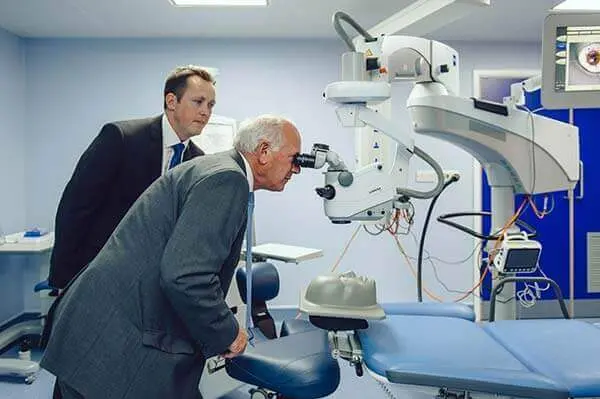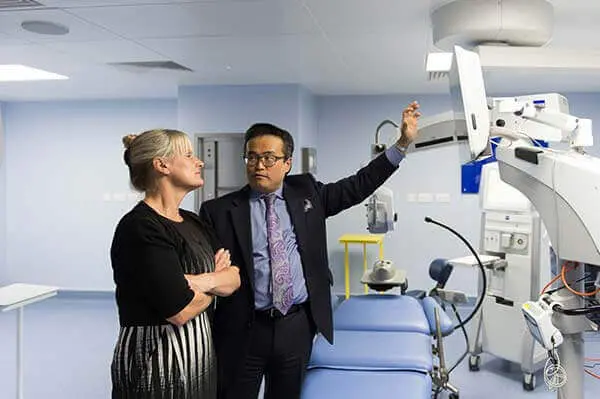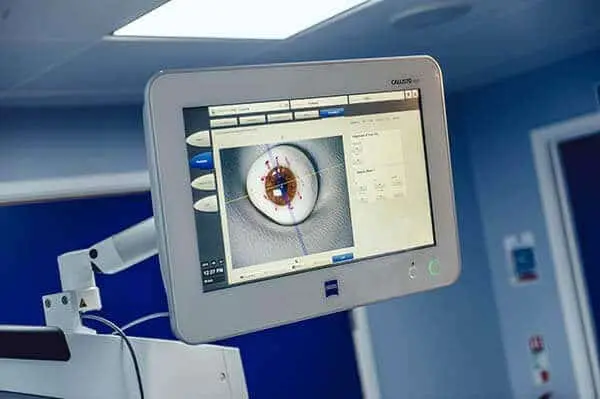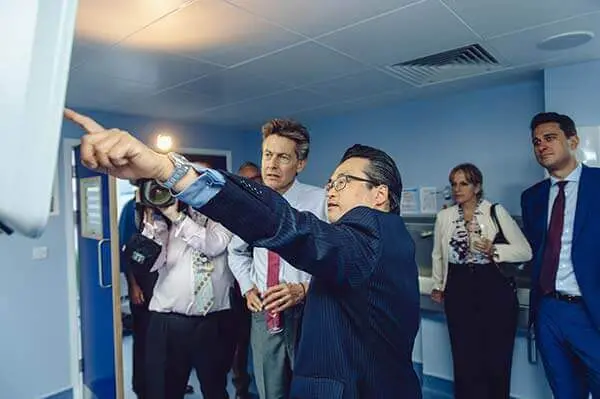Our Location
The Medical Eye Clinic,
Glen House,
Sigford Road,
Matford Park,
Exeter, EX2 8NL
Quick Contact
Call Us:
01392 829436
Contact us
Wet Macular Degeneration Treatment
Wet Macular Degeneration Treatment
What Treatment is Available?
The abnormal network of blood vessels, once formed, is dependent on a signalling molecule, the Vascular Endothelial Growth Factor (VEGF), to keep growing and leaking.
Anti-VEGF agents are engineered humanized antibodies against VEGF. They work by blocking the effect of VEGF on the abnormal network of blood vessels in wet AMD, causing the abnormal network of blood vessels to stop leaking and growing and thereby arresting the progression of wet AMD.
Treatment for Wet macular degeneration, therefore, requires Intravitreal Therapy (IVT) of repeated injections of Anti-VEGF agents into the vitreous cavity, the main eye cavity at the back of the eye, to ‘dry up’ the macula in Wet AMD.
What Anti-VEGF Agents are Available?
There are currently four Anti-VEGF agents which are effective and routinely used in the treatment of Wet macular degeneration.
- Bevacizumab (Avastin)
- Ranibizumab (Lucentis)
- Aflibercept (Eylea)
- Faricimab (Vabysmo)
The choice depends on the nature of your wet AMD and other funding/economic considerations. Your surgeon will discuss the choice of Anti-VEGF agents with you in detail.
What are the Aims of Treatment?
Intravitreal Therapy (IVT) with Anti-VEGF agents is able to stops further deterioration of the central vision in the majority of patients (95%) with Wet AMD. Furthermore, a small proportion of patients (20-30%) can experience major improvements in their vision.
However, the main aim of the treatment is to stop the decline in vision. It can be difficult to accurately predict whose vision will improve with treatment on an individual patient basis, but the vision is very likely to stabilise in the vast majority of patients.
To maintain the effects of treatment with Anti-VEGF agents, you will need to have regular check-up visits, with repeated IVT treatment with Anti-VEGF agents from your surgeon.
How is diabetic Macular degeneration tested?
If there is a suspicion of DMO, you will be referred to the eye hospital for a comprehensive evaluation. The ophthalmologist, a specialist in eye care, may employ various techniques to assess your condition: To obtain a clear view of the back of your eye, the ophthalmologist may use eye drops that dilate your pupils. Although these drops can temporarily cause blurry vision and sensitivity to light, it is advisable to have someone accompany you during this time.
Optical coherence tomography (OCT) scans may be conducted to generate detailed cross-sectional images of your retina. This non-invasive procedure aids in the examination and analysis of retinal structures. Another diagnostic method called fluorescein dye angiography involves injecting a dye into a vein in your arm. The dye travels to your eye, highlighting the blood vessels in the retina, which can then be captured through photography.
It is important to note that this dye may cause a temporary change in the colour of your urine. If any signs of DMO are detected through these Macular degeneration Tests, appropriate treatment and management strategies can be initiated to address the condition effectively.



What treatments are available for DMO?
As DMO is effectively the manifestation of diabetes in the eye, the treatment for DMO includes optimising the following system risk factors:
- Improve the control of diabetes.
- Improve the control of blood pressure.
- Improve the control of ‘lipid profile’.
In addition to these systemic measures, the following ‘eye-specific’ treatments can be used to treat DMO:
- Laser treatment. This is the conventional treatment for DMO, useful for treating DMO that does not directly involve the central vision. However, when DMO is very close to or involves the very centre of the macula, laser treatment can have the undesired effect of producing scarring in the central vision.
- Pharmacological treatment by intravitreal therapy This is when medication is injected into the main eye cavity, the vitreous, to treat DMO. This is the modern treatment that is preferable in most cases of DMO, especially when DMO is very close to or involves the central vision.
There are two main classes of medication that are effective in the treatment of DMO.
These are:
- Anti-VEGF therapy
- Steroid therapy
What is anti-VEGF therapy?
In order for the leaking capillaries in DMO to persist, they rely on specific signalling molecules known as Vascular Endothelial Growth Factor (VEGF). However, researchers have developed a solution in the form of anti-VEGF agents, which are engineered humanized antibodies designed to target and counteract the effects of VEGF on the leaking capillaries in DMO.
By doing so, these agents effectively “dry up” the macula affected by DMO. The administration of anti-VEGF agents involves a technique called intravitreal therapy (IVT), which entails multiple injections directly into the vitreous cavity located at the back of the eye, the main eye cavity.
What anti-VEGF agents are available?
There are currently three anti-VEGF agents that are effective and routinely used in the treatment of DMO.
- Bevacizumab (Avastin)
- Ranibizumab (Lucentis)
- Aflibercept (Eylea)
What is steroid therapy?
Ozurdex slow-release steroid implants present an alternative approach for intravitreal therapy in the treatment of DMO, serving as an effective option alongside anti-VEGF. This particularly holds true when dealing with severe and long-standing cases of DMO.
How do I choose between the different treatment options?
The selection of DMO therapy is contingent upon the specific attributes of your medical condition as well as other financial and economic factors. Your surgeon will engage in a comprehensive discussion with you to explore the various anti-VEGF agents available, delving into their intricacies.



What are the aims of treatment?
In the realm of ophthalmology, intravitreal therapy (IVT) stands as a powerful weapon against the progression of diabetic macular oedema (DMO). By administering anti-VEGF agents or steroids (Ozurdex), the majority of patients (around 90%) can halt any further deterioration of their central vision. Astonishingly, a small subset of patients (about 20–30%) may even witness substantial improvements in their vision. Nevertheless, it is important to note that the primary objective of this treatment is to prevent any decline in vision.
Ascertaining which individuals will experience vision enhancement on a case-by-case basis is indeed challenging. However, the vast majority of patients can rest assured that their vision will stabilise thanks to this therapy. In order to maintain the positive effects of the treatment, regular check-up visits will likely be necessary.
It is highly probable that repeated IVT treatments involving either anti-VEGF agents or steroids (Ozurdex) will be recommended by your surgeon. These measures ensure that the benefits of the therapy endure, safeguarding your precious vision.
What is intravitreal therapy?
In the field of ophthalmology, intravitreal therapy (IVT) stands as a widely practiced procedure wherein medication is administered through injection directly into the vitreous cavity, the primary cavity within the eye. This innovative approach has gained significant traction as a favoured treatment method for various retinal diseases.
What are the side effects of intravitreal therapy?
- Subconjunctival haemorrhage: The white of the eye, where the injection went in, is likely to go red. This is harmless and should disappear in a few days.
- Floaters: You may see a few ‘floaters’ or ‘spots’ in your vision. These spots are normal and should go away within a few days.
- Discomfort: You may experience some discomfort for the first 24–48 hours after IVT. These are often described as ‘gritty’ and ‘achy’ sensations and usually resolve after 48 hours. If you experience discomfort after IVT, paracetamol and/or ibuprofen in the first 24-48 hours should help resolve these symptoms.
What are the risks of having intravitreal injections?
IVT is a commonly performed procedure that has a very good safety profile. However, there are some potential risks, which are very rare:
- Infection: The most serious complication related to the injection of any medicine inside the eye is infection. Infection can lead to a potentially serious loss of sight. The risk of infection is approximately 1 in 1000.
- Retinal Detachment. There is also a very small risk of retinal detachment, estimated at 1 in 1000.
- Cataract. If you have a pre-existing cataract, this can sometimes progress following IVT. Cataract surgery can, however, be carried out at a later date.
Endophthalmitis, a dreaded complication that haunts the world of intravitreal injections (IVTs), instills fear among medical professionals. However, at the Medical Eye Clinic, we have taken extensive measures to counter this menace. Our cutting-edge operating theatre, a haven of technological advancements, serves as the exclusive venue for all IVTs.
This sets us apart from other eye clinics or the NHS, where the majority of IVTs are conducted in the outpatient clean room facility. Our commitment to excellence is further exemplified by the implementation of an advanced ‘Clean Air’ filtration system within our operating theater. This state-of-the-art technology creates an impeccably sterile environment, ensuring the highest standards of safety and care for our patients during IVT procedures.
What happens on the day of treatment?
- On the day of your injection, please do not wear makeup. You can eat and drink as normal before the injection.
- When you arrive for IVT, you will be ‘checked in’. You will be asked to confirm any allergies you might have, and a name band will be placed on your wrist.
- Eye drops will be given to dilate your pupil, and antibiotic drops will be given to prevent infections.
- You will be asked to sign a consent form before your first injection. The consent is given for a ‘course’ of IVT and therefore will be valid for subsequent injections.
The procedure:
- The procedure will take place in our state-of-the-art operating theatre.
- Your eye and the skin around your eye will be cleaned to avoid infection.
- Your face and the area around the eye will be covered with a special drape.
- A device will be used to hold your eye open.
- Your eye will be numbed with an anaesthetic drop so that there is minimum discomfort.
- Your eye surgeon will then give the injection into the white part of your eye.
- You may feel a little pressure on the eye when the injection is being given.
- The treatment should take about 15 minutes.
What can I expect after the treatment?
- You will be given antibiotic eye drops to use four times a day for five days.
- There are no restrictions on resuming normal activities.
- Your surgeon will usually arrange to see you for a check-up appointment 4 weeks’ after the injection, or 4 weeks following a course of injections.
- There is usually some discomfort for a few days after an injection. You are likely to experience some gritty sensations in your eye. This is normal and should resolve within a few days. The discomfort can be helped by taking paracetamol or ibuprofen for the first 24-48 hours after IVT.

